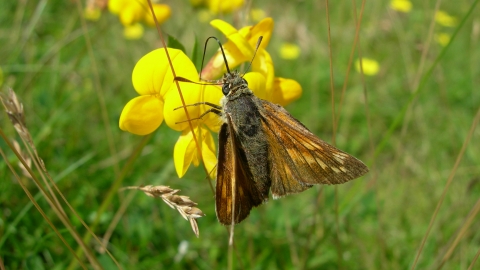
Broadhead Clough - Skipper butterfly



(c) Elliott Neep
Broadhead Clough Nature Reserve
Location
Know before you go
Dogs
Footpath only.
Please respect the local wildlife and keep dogs on a short lead.
When to visit
Opening times
Open at all times. We recommend a half day trip for this reserve.Best time to visit
September to OctoberAbout the reserve
In the 18th century, Broadhead Clough was home to the notorious Cragg Vale Coiners, who produced fake coins, but the real value of this site is in its rare wet woodland mires and Pennine fringe habitat. The peat mires support an abundance of moss and liverwort, including sphagnum and star mosses, with tufts of rush and other plants, including marsh orchid, and fungi, such as bog beacon. In turn, these conditions are ideal for invertebrate larvae, providing food for birds including curlew, cuckoo, woodpeckers, and finches.
Contact us
Environmental designation
About
The most important habitat of this diverse site is the rare wet woodland bog areas. A number of small streams flowing through the site spread out to form boggy areas known as mires, undermining tree roots and causing them to crack or the trees to fall prematurely. Fallen wood combined with the underlying peat soils, leaves and sphagnum moss rots away to form more peat bog.
There are 65 species of moss and liverwort here, which include sphagnum and star mosses, with tufts of rush and other wetland plants and fungi. This provides ideal conditions for the larvae of many invertebrates, which provides food for many charismatic birds including curlew, cuckoo, woodpeckers and finches that rely on the nature reserve for food or shelter.
Following the main footpath to the moorland commons above gives a stunning view onto the mires and across the whole nature reserve down the valley.
Seasonal highlights
- Spring: Plants - Wood sorrel; Marsh violet; Birds - Curlew; Cuckoo; Blackcap
- Summer: Plants - Marsh orchid; Cotton grass; Heather; Harebell; Bird's-foot trefoil
- Autumn: Fungi; Birds - Jay; Redwing; Fieldfare
- Winter: Birds - Woodcock; Red grouse; Tawny owl; Long-tailed tit; Mammals - Brown hare
History
The area was home to the Cragg Vale Coiners, an infamous gang of local criminals who produced fake gold coins in the late eighteenth century.
If you like social history arrange to also visit nearby Coiners Barn.
Directions
Public transport
Mytholmroyd has a station and regular buses from Halifax and Burnley. National Cycle Route 66 crosses the B6138: for cyclists who like a challenge this road is the longest continuous climb in England.
By car
Take the B6138, signposted Littleborough until ½ mile from Mytholmroyd, the houses on the right give way to fields. Visitors’ vehicles are not allowed to use the track to the nature reserve and should be parked on the roadside. Immediately before the road swings left and right to cross Dauber Bridge, there is a track on the right, with a public footpath sign to Frost Hole. Walk along the track for about a ¼ mile, fork left onto the concrete road until you reach the main entrance (0.6 miles from the road).

The autumn colours were even more beautiful when the sun came out
Photo Credit - Telling our Story Volunteer, Sara


